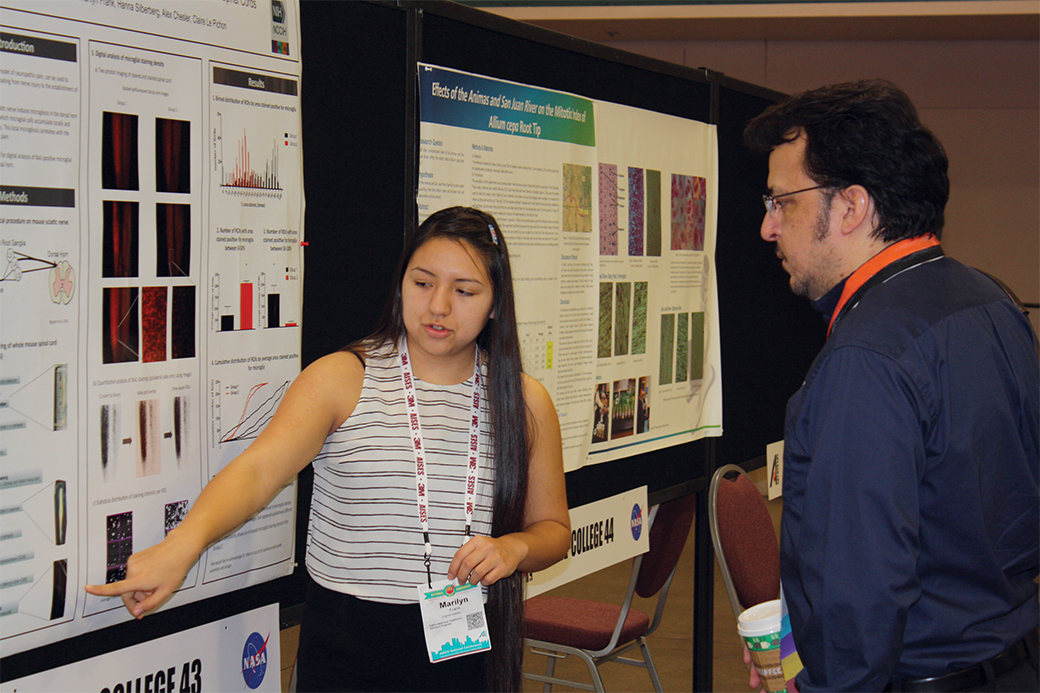
Medical school grant makes college transition easier for Native American high school students
A USD Sanford School of Medicine program, which was created to encourage Native Americans to pursue higher education and careers in the healthcare sector, is seeing success so far in its first year.
The Native American Healthcare Scholars Program (NAHSP) provides mentoring and assistance to students as they work their way toward and through a medical education. It includes regular access to faculty and student mentors, two trips to USD and the opportunity to attend the annual AISES National Conference.
“The reason for the program, long story short, is to increase the number of health care professionals in our Native American communities, on our reservations,” said NAHSP coordinator Kathy VanKley. “Because, just as the rest of the United States is facing a shortage of healthcare professionals, it tends to be even worse in our reservation area.”
There are currently 15 students enrolled in NAHSP.
Applicants are accepted from Red Cloud Indian School in Pine Ridge, S.D. and Wagner Community High School in Wagner, S.D. The next round of applicants will be accepted this March, VanKley said.
Students enter the program in their junior year of high school and can remain in it all through college if they go to USD.
“If they go somewhere else, we’d like to keep in contact with them, but we can’t offer them what we would be able to offer here as far as additional services,” VanKley said.
Funded through the Office of Minority Health, the program receives $446,761 per year for five years. VanKley said USD’s program could become a pipeline model that’s replicated at other schools. For this reason, the program is continually undergoing an evaluation process, she added.
“So after we have events we do evaluations, the students themselves will do online evaluations, parents will do evaluations throughout the project to see what things are working, what could work better,” she said.
Marilyn Frank, a senior at Red Cloud High School, is one student in the program.
As someone who’s very interested in science, math, engineering and healthcare, Frank said she was very happy to be accepted into the program.
“I knew that we’d get kind of exposed to many things and many people,” she said. “So I thought it was really exciting.”
Frank has also participated in the Indians into Medicine (INMED) and was an intern at the National Institute of Health in Maryland last summer. During her eight-week internship, she did research on a methodology to visually analyze injured spinal cords. Frank was able to present her research at the AISES conference in November, which she said was the experience that impacted her the most since her acceptance into NAHSP.
“That was very helpful,” she said.
VanKley said attending the AISES conference helped the NAHSP students understand that what they’re doing now is preparing them for their futures.
“For them to go to this conference and see all the positive things that are happening in the Native world and to be able to take that motivation home with them, it was just neat,” she said. “…They did all kinds of things that would help advance them academically and career-wise, but they also got to see every level of that professional development from high school students, to being in college, to being a professional out in whatever field they’re personally in.”
As the INMED program coordinator for South Dakota and North Dakota, VanKley has worked in schools with Native American populations for several years.
“I’ve been all over. I love it,” she said. “I’ve been able to work with the kids in those schools for quite a long time.”
A ‘productive relationship’
Laura Fox, a fifth-year M.D./Ph.D. student, has been a NAHSP mentor since last fall.
Because Fox had already met Connor Richards, the senior from Red Cloud Indian School she was asked to mentor, she knew he was a hard worker and asked good questions.
So far, Fox said the relationship has gone very well. The two communicate via email, text and Facebook messaging, sometimes as much as every other day.
“It’s been wonderful,” she said. “I must give him a lot of credit for using me correctly.”
Richards was paired with Fox because he’s interested in the M.D./Ph.D. track. Fox said they’ve talked a lot about college interviews, essays and applications so far this year.
“The administrators of the program did a great job setting us up to have a productive relationship,” she said.
Fox is originally from a town 50 miles east of Seattle, which she said shares a lot of similarities with Pine Ridge. Though she’s not Native American herself, she did grow up near a reservation.
After graduating from a high school with a drop out rate of 64 percent, she got her undergraduate degree at Cornell University. She chose USD’s medical school because of its structure, education style and its people, she said.
“They’re the sweetest people. In my medical school class, my teachers, professors,” she said. “It was a very kind campus, and that was as attractive as its academic strengths.”
One of the reasons Fox believes NAHSP is so important is that it shows high school students that success is valued and being a goal-oriented person is something to celebrate.
“(Richards) is so excited to be in an environment like college where he feels like he’s not the strange one for having academic goals,” she said. “And this program gives him the chance to see that.”


